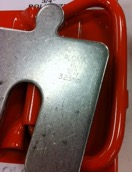Some companies don’t stock all sizes of shims-probably to save money. But using the proper size shim is critical to providing a solid mounting for the machine feet.
Which brings up a good question….
Just how much of the foot should be supported by shim?
Some shim manufacturers (Lawton and Accushim as examples) rate their shim sizes by horsepower or frame size of the motor they support. So if you are using a standard NEMA frame motor, you can look up the right size shim for your application.
But, not every machine being shimmed meets NEMA specs. So, according to The Shaft Alignment Handbook (J. Piotrowski):
–The rule of thumb is provide at least 80% contact between each machined foot and its point of contact on a baseplate, frame, or soleplate (The Shaft Alignment Handbook, 3rd Edition, p.300).
I have always tried for a minimum of 50% contact, while making sure the shim is equal around the periphery of the bolt. In other words, there should be an equal amount of shim all the way around the bolt, except for the slot.
That being said, one would have to consider not only the physical dimensions of the shim and foot, but also factor in the mass of the machine, and dynamic radial and axial forces imparted to the foot during operation of the machine. Because a shim in essence makes the foot contact area smaller. So, I blew the dust off my old Statics book, and found out that the modulus of elasticity for 304 stainless steel is about 11.2 million psi, with a Rockwell hardness of 80B. Translated, it’s pretty hard, tough, and strong! So, does it really need to be 80%, or even 50% for that matter?
80% sounds good to me. 50% might be OK too. My guess is if it looks like it is supporting the weight of the machine, plus the forces imparted by bolting, it’s probably OK. Conversely, if it looks like a tiny shim under a really big foot, it probably isn’t OK.
Get a bigger shim.





Comments